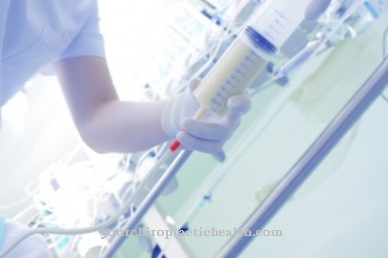A Bone marrow puncture is carried out to obtain biopsy arterial in order to diagnose hematological diseases such as leukemia, malignant lymphoma or plamocytoma. Before blood products are transfused (bone marrow donation), the donor's bone marrow is subjected to a compatibility test.
What is the bone marrow puncture?

The bone marrow puncture is a small procedure (15 minutes) and takes place via a puncture in the bone marrow, preferably in the iliac crest or sternum (breastbone). The procedure is performed under local anesthesia with a special cannula to obtain biopsy material.
For this reason, this puncture process is also called Bone marrow biopsy designated. The doctor takes a small amount of bone marrow from the breastbone (sternum) or the posterior iliac crest. In the laboratory, the different blood cells can be easily seen under the microscope.
Function, effect & goals
The bone marrow makes up most of the blood cells in the human organism. With a few exceptions, it is the origin of all blood cells and forms inside the bones. The bone marrow is the prerequisite for proper blood formation and should not be confused with the spinal cord that runs in the center of the spine and consists of nerve cords. The nerve cords connect the nerve lines with the brain. The stem cells, also called blasts, are the precursors of the blood cells. These stem cells and a certain number of mature blood cells reside in the meshes of bone tissue.
A bone marrow puncture is therefore to be seen separately from the spinal cord puncture. Medicine distinguishes three cell systems. The erythrocytes (red blood cells) are responsible for transporting oxygen. The leukocytes (white blood cells) are used to fight pathogens. The thrombocytes (blood platelets) ensure proper blood clotting. A bone marrow puncture is done if the patient is suspected of having a diseased hematopoietic system.
A follow-up check can also be carried out with a bone marrow biopsy. Diseases that can be reliably diagnosed by a biopsy are special forms of anemia, various types of leukemia, in which there is a disease of the white blood cells, and a reduction in the number of blood-forming cells (bone marrow aplasia).
The reverse variant, the multiplication of all cell systems (polycythemia vera) is also determined in this way. Doctors detect daughter tumors of certain types of tumors such as breast cancer and prostate cancer that can accumulate in the bone marrow. Diseases of the lymphatic system such as lymphomas are also diagnosed with the help of this procedure. A punch biopsy of the pelvic bones, mostly on the posterior iliac crest, is preferably performed. In the case of patients receiving intensive medical care, doctors also switch to the anterior iliac crest. The sternal bone marrow puncture is only performed in exceptional cases, when the posterior iliac crest can no longer be felt due to excessive weight.
The cells obtained from the sample material are examined microscopically and provide information about the cell density and the number of individual cell types (platelets, white and red platelets). The puncture site is stuck with a plaster. The patient gets a small sandbag pushed under the back of the pelvis, on which he has to stay for a while to stop the bleeding.
You can find your medication here
➔ Medicines for painRisks, side effects & dangers
One focus of hematology is the taking of tissue and blood samples in order to facilitate the subsequent diagnosis, because doctors gain important knowledge from the characterization of tissue cells and the analysis of blood components for the assessment of malignant diseases. In many cases, drawing blood or tissue is the first step in diagnosing and treating many cancers. The blood count is differentiated by a normal blood sample.
Doctors can see abnormally changed cells under the microscope. During the bone marrow biopsy, doctors take the bone marrow from the posterior iliac crest because there is no risk of injuring the surrounding organs at this point. The patient lies on his side with his legs bent or in a stretched prone position. The sternum is punctured in the supine position. The puncture site is disinfected and locally anesthetized. A puncture needle is inserted through the skin and the bone substance into the bone marrow. A small cylinder of bone marrow (punch biopsy) is taken from this puncture site. Alternatively, a syringe attached to the puncture needle can be used to remove a small amount of bone marrow with a short, forceful pull (aspiration).
Doctors usually refrain from performing a sternal puncture because it is more painful than removing tissue from the posterior iliac crest. There is a greater risk of injury to the surrounding organs of the chest such as the heart and lungs, as well as the large blood vessels in the immediate vicinity of the puncture needle. Sedatives or pain relievers are usually not necessary, but can be given at the patient's request. The examination of the material obtained is carried out, if necessary, by additional molecular genetic or immunological examinations.
If a tumor is diagnosed by the bone marrow puncture, the so-called staging diagnosis can follow the initial diagnosis. This includes examinations that classify a tumor disease or leukemia into different stages. In addition to the physiological examination, diagnostic imaging (mammography, computed tomography, sonography, magnetic resonance imaging, nuclear medical examinations, PET-CT) is possible. Endoscopy (mirroring), laparoscopy (laparoscopy) or endosonography supplement the previous examinations if necessary. This procedure is often carried out on an outpatient basis. The doctors advise their patients not to expose themselves to physical strain in the hours after the puncture and not to actively participate in road traffic for the next 24 hours.
Bone marrow biopsy is a procedure that usually does not cause complications. However, before the procedure, doctors point out possible complications to their patients, which, however, rarely occur. The administration of sedatives and pain relievers can lead to irregularities in the respiratory function. Bruising and bleeding may occur in the immediate vicinity of the puncture site. Injury to the surrounding organs, nerves, soft tissues or skin is possible.













.jpg)

.jpg)
.jpg)











.jpg)